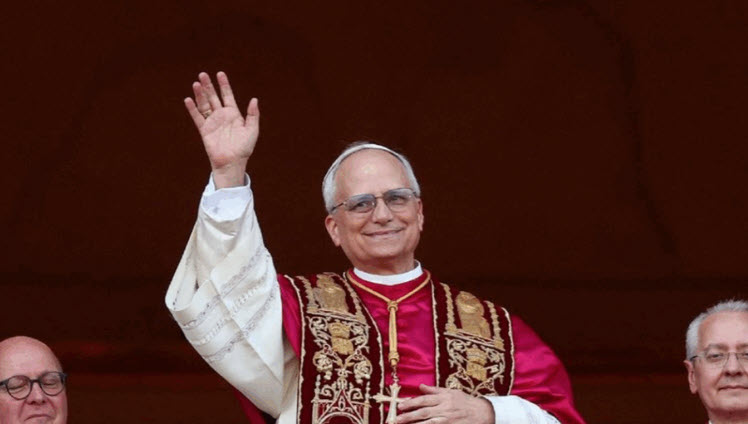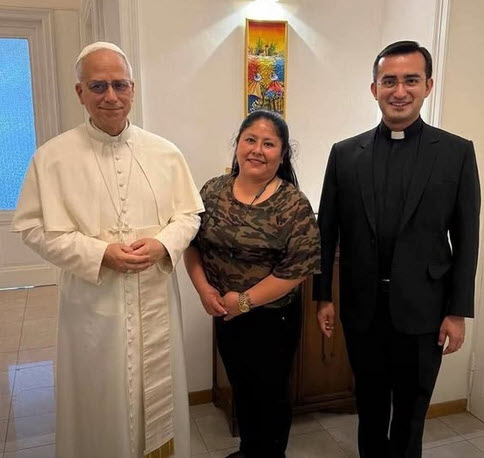 Pope Leo XIV’s first appearance on the Vatican balcony. Source: Vatican News
Pope Leo XIV’s first appearance on the Vatican balcony. Source: Vatican News
By Poppy Tollemache ✐ Peruvian Times Contributing Writer
Though born in Chicago, Pope Leo XIV—formerly Robert Prevost—spent more than three decades living and serving in Peru, becoming a dual citizen in 2015. “I came as a missionary to Chulucanas almost 40 years ago, then 11 years in Trujillo and eight years in Chiclayo,” he told Catholic News Agency. “I thank God for so many things the Peruvian people have shared with me. We have walked together and shared our faith.”
Pope Leo XIV sets four precedents since his election to lead the Catholic Church. He is the first Augustinian to occupy the throne of Peter, the first naturalized Peruvian citizen in that role, the first pope from North America, and the first native English-speaker since Pope Adrian IV in the 12th century.
In Peru, the word papa means both “pope” and, of course, “potato,” the Andean tuber that is central to Peruvian identity. The election of Pope Leo XIV sparked a wave of humour and pride on social media, with memes depicting the pontiff as an Andean potato or riding horses through the Andes. The Pope himself joked with cardinals at the Vatican, “I’m another variety of Peruvian papa.” Beyond light-hearted fun, the sentiment reveals how deeply Peru claims him as nuestro Papa “our Pope.”
A video of parishioners in Chiclayo watching Pope Leo XIV’s first address quickly went viral, capturing their ecstatic cheers as the newly elected pontiff paused mid-speech to deliver a brief message in Spanish:
“Un saludo a todos, y en modo particular a mi querida diócesis de Chiclayo, en el Perú.”
“A greeting to all, and in particular to my dear Diocese of Chiclayo, in Peru.”
 Pope Leo with his personal chef, Veronica Sanchez, and his private secretary, Father Edgar Rimaycuna, both from Chiclayo. Source: Cosas
Pope Leo with his personal chef, Veronica Sanchez, and his private secretary, Father Edgar Rimaycuna, both from Chiclayo. Source: Cosas
For many Peruvians, the moment was more than symbolic, it was a powerful affirmation of identity. In its wake, both Peru and the wider South American continent, home to nearly 40% of the world’s Catholics, are embracing Pope Leo XIV as a native. This view was affirmed when it was revealed that he had even appointed a Peruvian, Verónica Sánchez Molina, as his personal chef at the Vatican.
His private secretary, Father Edgar Rimaycuna Inga, is also Peruvian. Inga studied at the Pontifical Biblical Institute in Rome and in 2023, when then-Archbishop Prevost began to work at the Congregation for Bishops in Rome, Inga was asked to join him as his secretary and now continues in that role.
Peru’s President Dina Boluarte lauded him as “Peruvian by choice and conviction” and declared, “The pope is Peruvian; God loves Peru.” Yet some political tensions shadow the moment, with the public urging the Pope to avoid meeting Boluarte amid corruption allegations.
A Life Dedicated to Peru’s People
Bishop Paolo Gualtieri, the Papal Nuncio to Lima, describes Leo XIV’s time in Peru as transformative. “He spent the greater part of his life here, gaining profound experience as a missionary, pastor, educator, and bishop,” Bishop Gualtieri said in an interview with La República. “He truly gave his heart to Peru.”
“The people feel very close to him,” Gualtieri said. “I remember his first visit back to Peru as a Cardinal. I had the honour of accompanying him to Chiclayo, and the welcome was overwhelming. It was clear that he had been a pastor who walked with his people.”
 Pope Leo when he was Bishop Robert Prevost of Chiclayo, travelled often on horseback to remote areas. Source: Diócesis de Chiclayo.
Pope Leo when he was Bishop Robert Prevost of Chiclayo, travelled often on horseback to remote areas. Source: Diócesis de Chiclayo.
From the Amazonian town of Iquitos to the coastal city of Chiclayo, Pope Leo XIV spent years serving in some of Peru’s most underserved communities. His work took place during a difficult chapter in the country’s recent history, the internal conflict of the 1980s and 1990s. This period was marked by violence between government forces and the insurgent groups Shining Path and the MRTA when, according to Peru’s Truth and Reconciliation Commission (CVR), approximately 69,280 people were killed or disappeared. The majority of the victims were civilians, many from rural and indigenous communities. Throughout those years, Leo XIV became a consistent voice for compassion and support, particularly for those most affected by the unrest.
During the catastrophic coastal El Niño floods of 2017, locals remember him wading through waist-high waters to deliver aid. Moreover, amid the COVID-19 pandemic, he spearheaded the installation of oxygen plants in partnership with Caritas, the Catholic aid organisation, to support the overwhelmed health system in Lambayeque.
A Dual Identity for a Divided Continent
Many feel that Pope Leo XIV’s unique background could create a bridge between the United States and Latin America, fostering greater compassion and understanding in international relations.
Throughout his career, Leo XIV has been an outspoken critic of strict immigration policies. In his inaugural address to world diplomats at the Vatican on May 16, 2025, he emphasised the importance of respecting the dignity of migrants. This sentiment is supported by his advocacy of Peru’s open-border policy to Venezuelan asylum-seekers during the current humanitarian crisis. This stance is particularly significant amid growing debates on immigration reform and border control in the Americas.
His lived experience in both North and South America gives him a nuanced perspective on the challenges faced by migrants, refugees, and marginalised communities. This dual identity shapes his pastoral approach and establishes him as a moral voice, able to advocate for policies grounded in collaboration, empathy, and solidarity—principles essential for addressing long-standing divides. Perhaps, this is why Peru is so eager to claim him as their own.